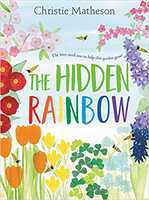Literary
The Hidden Rainbow

This delightful picture book is packed with early literacy and nature learning! Colors, counting, and gardening concepts are all a part of this adventure of discovering the colors of the rainbow. The book has interactive prompts to engage young children in dialogic reading and make reading fun. The bright illustrations add visual appeal while the rhyming text introduces blossoms, fruits, and the role of honeybees in the production of healthy food.
Educator notes:
Informational
Flowers are Calling

Rhyming and repetitive text will captivate young readers as they learn about pollinators in this nature inspired informational text. The shapes, patterns and time of day that flowers bloom affect which pollinators are attracted and needed by each blossom. Beautiful illustrations combined with quality botanical information makes this book an exciting part of nature discovery!
Educator notes:
Topic: Flowers, pollinators, Colors, Nature
Age: Preschool
Active Learning Strategy: Scavenger Hunt
Type: Individual and Whole Group Exercise Title: Nature I Spy
Learning Objectives: The student will:
Description:
This scavenger hunt activity involves students using their senses to observe, explore, and discuss what they see, hear, smell or notice in the texts and in an outdoor environment. Observations will create the opportunity to learn and interact with nature and can be done in a variety of settings. Students will be provided time to discover individually and with other members of their class and to record observations with flashcards that will be used to make a shared bulletin board, poster or scavenger hunt collage.
Materials:
Direct Instruction:
Guided and Independent Practice:
Reinforce color identification and counting through songs and other practice. Lead discussion involving comparison of general or specific nature observations, and convey expectations involving the scavenger hunt. Encourage students to use all their senses during their exploration. Connecting to the local environment will deepen the knowledge building of the student's own, observable natural world. Seasonal changes can also be a great learning topic,and scavenger hunts allow for discovery of these changes while reinforcing counting and color identification.
Sharing/Reflection/Closing:
Scavenger hunts are not only fun but a great way to strengthen early literacy skills and concepts.This activity can be adapted in so many different ways and with different literature texts. As part of a larger curriculum about nature and eco literacy, this activity is a wonderfully engaging introduction to flowers, pollinators, and using the senses to explore nature. |
